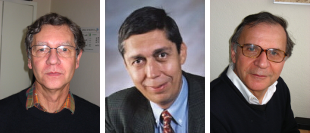JPH and the Orsay group
 In the 1960s three young students, Dominique Levesque, Jean-Pierre Hansen, and Jean-Jacques Weis joined, one after the other, Loup Verlet at the Université de Paris-Sud for their PhD theses. It was the foundation of the legendary Orsay-group and – concomitantly – the initiation of the eminent role that the European scientific community has played ever since in atomistic and molecular simulations. Driven by the fascination for the novel technique and by their enthusiasm, the three young members of the group set milestones in the early days of computer simulations. In view of present day’s supercomputers one should bear in mind, that these pioneers had to work under conditions that seem nowadays unthinkable: to run the most sophisticated simulations of that time, codes hat to be written in Assembly Language and the UNIVAC computers of the University had to be taken over during nights and week-ends to run the codes as long and as efficiently as possible. The outcome was remarkable since the Orsay-group invariably produced new and exciting results.
In the 1960s three young students, Dominique Levesque, Jean-Pierre Hansen, and Jean-Jacques Weis joined, one after the other, Loup Verlet at the Université de Paris-Sud for their PhD theses. It was the foundation of the legendary Orsay-group and – concomitantly – the initiation of the eminent role that the European scientific community has played ever since in atomistic and molecular simulations. Driven by the fascination for the novel technique and by their enthusiasm, the three young members of the group set milestones in the early days of computer simulations. In view of present day’s supercomputers one should bear in mind, that these pioneers had to work under conditions that seem nowadays unthinkable: to run the most sophisticated simulations of that time, codes hat to be written in Assembly Language and the UNIVAC computers of the University had to be taken over during nights and week-ends to run the codes as long and as efficiently as possible. The outcome was remarkable since the Orsay-group invariably produced new and exciting results.
Quickly, Orsay became one of the world-wide leading centers in atomistic and molecular sim- ulations, hosting on a regular basis distinguished visitors from Europe and North America, amongst them, notably, Berni Alder. From a present day’s perspective it was only a logical decision that CECAM, the ”Centre Européen de Calcul Atomique et Moléculaire”, was founded in the early 1960s in Orsay.
Even after Jean-Pierre Hansen had left Orsay and started an international career, the three members of this first Statistical Mechanics simulation group in Europe exerted over decades a profound and lasting influence on the simulation community worldwide. The group significantly contributed to fully establish computer simulations within the scientific community, on equal footing with theory and experiment.

 In the 1960s three young students, Dominique Levesque, Jean-Pierre Hansen, and Jean-Jacques Weis joined, one after the other, Loup Verlet at the Université de Paris-Sud for their PhD theses. It was the foundation of the legendary Orsay-group and – concomitantly – the initiation of the eminent role that the European scientific community has played ever since in atomistic and molecular simulations. Driven by the fascination for the novel technique and by their enthusiasm, the three young members of the group set milestones in the early days of computer simulations. In view of present day’s supercomputers one should bear in mind, that these pioneers had to work under conditions that seem nowadays unthinkable: to run the most sophisticated simulations of that time, codes hat to be written in Assembly Language and the UNIVAC computers of the University had to be taken over during nights and week-ends to run the codes as long and as efficiently as possible. The outcome was remarkable since the Orsay-group invariably produced new and exciting results.
In the 1960s three young students, Dominique Levesque, Jean-Pierre Hansen, and Jean-Jacques Weis joined, one after the other, Loup Verlet at the Université de Paris-Sud for their PhD theses. It was the foundation of the legendary Orsay-group and – concomitantly – the initiation of the eminent role that the European scientific community has played ever since in atomistic and molecular simulations. Driven by the fascination for the novel technique and by their enthusiasm, the three young members of the group set milestones in the early days of computer simulations. In view of present day’s supercomputers one should bear in mind, that these pioneers had to work under conditions that seem nowadays unthinkable: to run the most sophisticated simulations of that time, codes hat to be written in Assembly Language and the UNIVAC computers of the University had to be taken over during nights and week-ends to run the codes as long and as efficiently as possible. The outcome was remarkable since the Orsay-group invariably produced new and exciting results.
